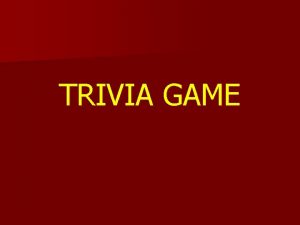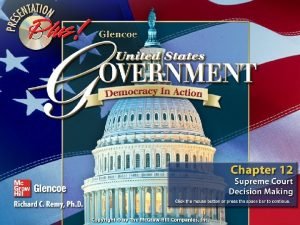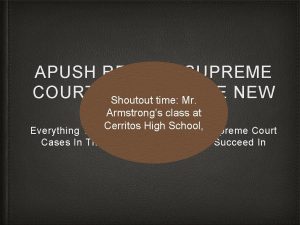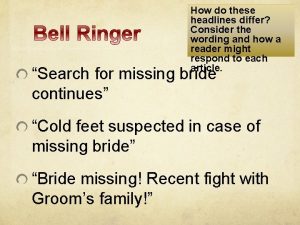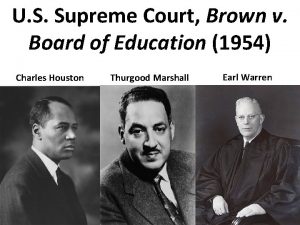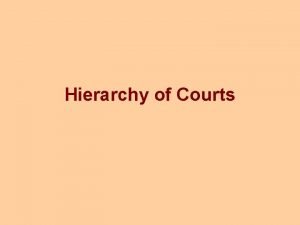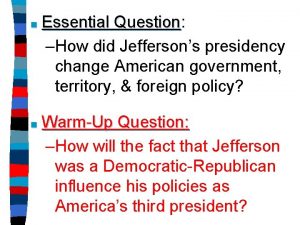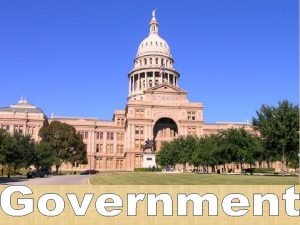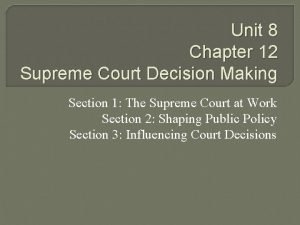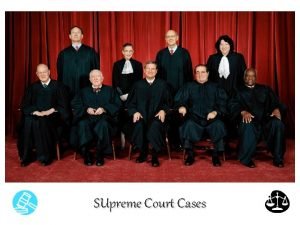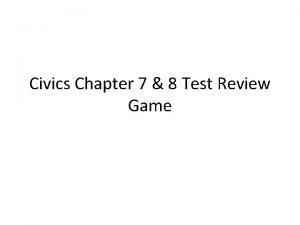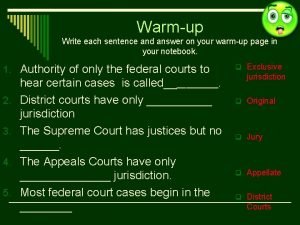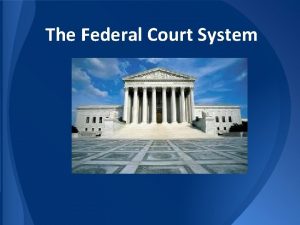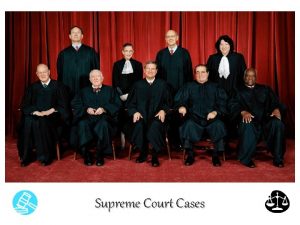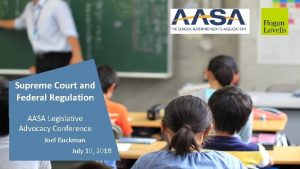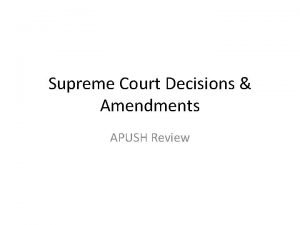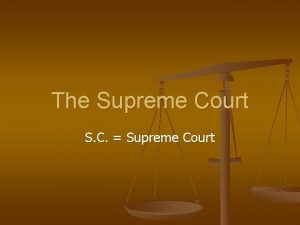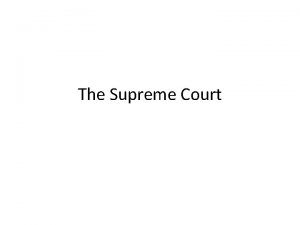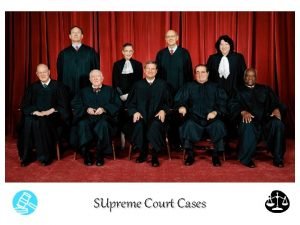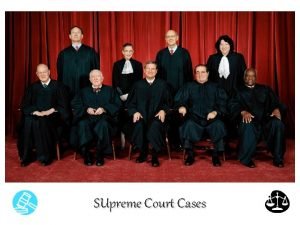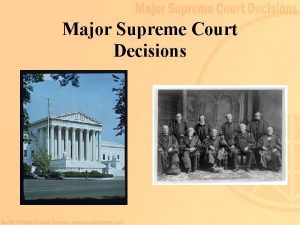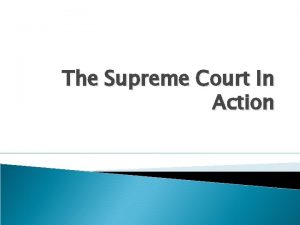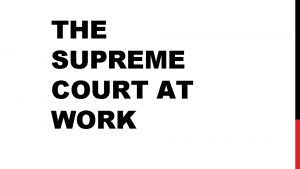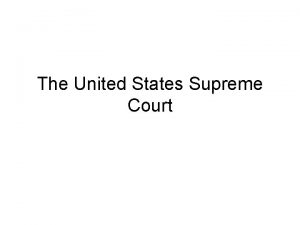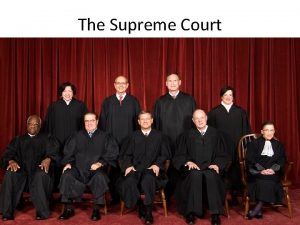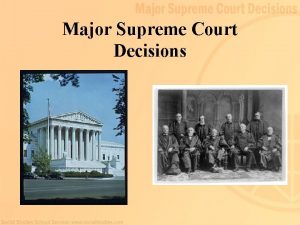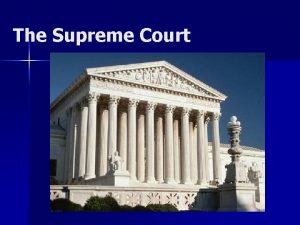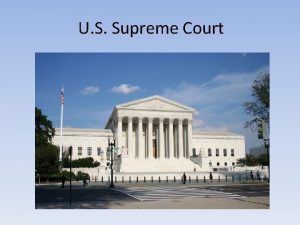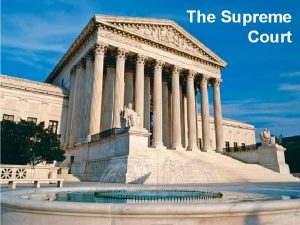The Supreme Court The Supreme Court The Supreme

















- Slides: 17

The Supreme Court

The Supreme Court • The Supreme Court is the only court specifically created by the Constitution. • The Supreme Court is the court of last resort in all questions of federal law. – It is the final authority in any case involving any question arising under the Constitution, an act of Congress, or a treaty of the United States.

Who sits on the Supreme Court? • There is one Chief Justice of the Supreme Court. – Chief Justice John Roberts • Along with the Chief Justice there are eight associate Justices. – Sonia Sotomayer, Stephen Breyer, Samuel Alito, Elena Kagan, Clarence Thomas, Antonin Scalia, Anthony Kennedy, and Ruth Bader Ginsburg. • All Justices are nominated by the President and confirmed by the Senate. The Justices can serve for life.


Marbury v. Madison • This is the first case where the Court asserted its power of Judicial review. • President Adams attempted to pack the courts with Federalists prior to leaving office in 1800. • When President Jefferson became President he prevented the appointment of these Judges. • William Marbury brought this case to the Court. – Chief Justice John Marshall declared that the act of Congress that Marbury was using to Justify his suit was invalid – This established the power of Judicial Review.

Judicial Review • Judicial Review is the power to decide the constitutionality of an act of government. – It can exercise this power over the executive, legislative, and Judicial branches. – The Supreme Court is the final authority on the meaning of the Constitution. • The power of judicial review is not specifically stated in the Constitution.

Supreme Court Jurisdiction • The Supreme Court has both original and appellate jurisdiction. – Most of the cases reach the Supreme Court on appeal from the lower federal courts. • Article III section 2 of the Constitution states that the High Court has original jurisdiction in two areas – In cases where in which a State is a party – Those affecting ambassadors, other public ministers, and consuls. • The Court has the option to exercise its jurisdiction over any case that fit into those catagories

How cases reach the court • Over 8000 cases are appealed to the Supreme Court each year. – Most cases are denied, due to the Court agreeing with the lower courts decision. • The court applies the “rule of four” when deciding which cases to hear. – At least four justices must agree to hear the case before it is put on the docket. • A writ of certiorari can be issued to send the case to the Court and is usually due to an important constitutional issue • A certificate is issued when a lower court is uncertain how to rule and send the case to the Supreme Court.

How the Court Works • When the Supreme Court takes on a case they first hear oral arguments. – Each side is given 30 minutes to present their case. – The Court is given briefs from both sides to evaluate. • The Justices then enter a Court in Conference. – The justices convene and debate the case and are polled on their decision.

Opinions • Majority Opinion – It announces the Court’s decision in a case and sets out the reasoning on which it is based. – These decisions become precedents. • Examples to be followed in similar cases as they arise in the lower courts. • Dissenting Opinion – Are opinions that are written by justices that do not agree with the Courts majority decision.

The Special Courts • There are six special courts that handle specific law suits at the Federal level. – U. S. Court of Federal Claims – Territorial Courts – U. S. Tax Court – U. S. Court of Appeals for the Armed Forces – U. S. Court of Appeals for Veterans Claims – Courts of the District of Columbia

Territorial Courts • These courts deal with federal issues and appellate issues in the U. S. territories. – U. S. territories outside the U. S. • Guam • Virgin Islands • Northern Marianas – They function like local courts in the other 50 states.

The District of Columbia Courts • The courts for the District of Columbia were set up to be the judicial system for the city. – They function as the local courts for the city and handle local cases.

Tax Court • The Tax court was established in 1969. • The tax court only hears civil cases. – These cases have to deal with the application of tax law. – Cases are generated by the IRS and the Treasury department.

• How did the Court’s decision affect the role of the judicial branch in our system of government – It expanded the judicial branch’s role by introducing judicial review.

• Why do you think this process requires so many steps to reach the Supreme Court? – The Supreme Court has time only to hear a limited number of cases.

Quick Write • How does the life long appointments to the Supreme Court affect the rulings made by the High Court?
 Is there a basketball court above the supreme court
Is there a basketball court above the supreme court Supreme court does
Supreme court does Supreme court cases apush
Supreme court cases apush What do these headlines say about how the supreme court
What do these headlines say about how the supreme court Supreme court
Supreme court Jurisdiction of supreme court
Jurisdiction of supreme court John marshall supreme court
John marshall supreme court Have supreme court
Have supreme court Vocabulary activity 12 supreme court decision making
Vocabulary activity 12 supreme court decision making Insular cases apush
Insular cases apush The u.s. supreme court works chiefly as a(n)
The u.s. supreme court works chiefly as a(n) How cases reach the supreme court worksheet answers
How cases reach the supreme court worksheet answers The supreme court
The supreme court Supreme court justice system
Supreme court justice system Which precedent was established by marbury v. madison
Which precedent was established by marbury v. madison Cohens vs virginia apush
Cohens vs virginia apush Supreme court does
Supreme court does Warren court apush
Warren court apush
